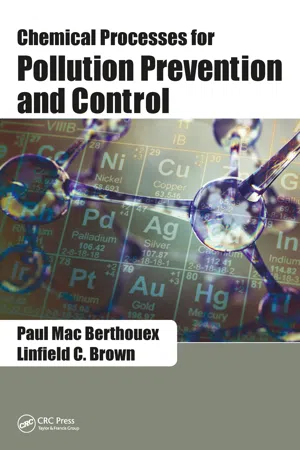Chemistry
Neutralisation Reaction
Neutralisation reaction is a chemical reaction between an acid and a base, resulting in the formation of water and a salt. The reaction involves the transfer of protons from the acid to the base, leading to the neutralization of their acidic and basic properties. This process is commonly used to neutralize the effects of acidic or basic substances.
Written by Perlego with AI-assistance
Related key terms
Related key terms
1 of 4
Related key terms
1 of 3
7 Key excerpts on "Neutralisation Reaction"
- eBook - ePub
A Mole of Chemistry
An Historical and Conceptual Approach to Fundamental Ideas in Chemistry
- Caroline Desgranges, Jerome Delhommelle(Authors)
- 2020(Publication Date)
- CRC Press(Publisher)
− and is evidently independent of the nature of the acid and the base. The development of heat in any reaction of this kind must therefore always be the same for equivalent quantities of any acids and bases”. He also finds that this heat of neutralization is always equal to 13,600 calories at 18°C!FIGURE 5.3 Sodium ion in an aqueous solution.Now, let us look at water. Following what precedes, water should dissociate into H+ and OH− , or in other words, H2 O → H+ + OH− . This equation is also known as hydrolysis. This means that H2 O is both an acid and a base, since it releases H+ and OH− ! However, Arrhenius states that “water is hardly dissociated at all” meaning that “water can be regarded as a weak acid or base”. He thus introduces the concept of weak acids and weak bases to account for compounds that do not entirely dissociate in water. On the other hand, strong acids or bases are compounds that completely dissociate in water. For example, HCl, HNO3 , H2 SO4 and HClO4 are strong acids, while NaOH, KOH, LiOH and Ca(OH)2 are strong bases. As for weak acids, we have acetic acid H3 COOH which partially dissociates into CH3 COO− and H+ . The equation is then written as H3 COOH = CH3 COO− + H+ . Here the sign “=” shows the partial dissociation, while the sign “→” is usually used for a complete dissociation. Another example is phosphoric acid H3 PO4 which gives H3 PO4 = H2 PO4 − + H+ . Regarding weak bases, we have ammonium hydroxide NH4 OH which dissociates into NH4 OH = NH4 + + OH− - eBook - ePub
Chemistry
Concepts and Problems, A Self-Teaching Guide
- Richard Post, Chad Snyder, Clifford C. Houk(Authors)
- 2020(Publication Date)
- Jossey-Bass(Publisher)
would (increase, decrease) __________.Answer: decrease; increaseBoth the acidic and the basic buffer systems react with small additional quantities of H+ and OH− to shift a buffer equilibrium. Instead of remaining in solution, the extra H+ or OH− ions serve to shift the equilibrium and result in an increase (or decrease) of the weak acid or base and a decrease (or increase) in the salt of the acid or base. The final result is a relatively small change in the pH rather than a large change. Buffering action will continue until so much H+ or OH− is added that one of the equilibrants is mostly used up.A buffer solution is useful for maintaining a relatively constant pH if small quantities of __________ or __________ are added to the solution.Here are other important equilibria involved in physiological processes.Answer: H+ ; OH−We now examine the situation where just adding a salt to water may change the pH of the water.HYDROLYSIS OF SALTS
A salt is a product of the neutralization of an acid and a base. Common table salt (NaCl) is a product of the neutralization reaction involving HCI acid and Na OH base.A salt can be a product of (a) a strong acid and a strong base, (b) a strong acid and a weak base, (c) a weak acid and a strong base, or (d) a weak acid and a weak base. HCl is a strong acid (completely dissociated). NaOH is a strong base (completely dissociated). NaCl is a product of a __________ acid and a __________ base. - Paul Mac Berthouex, Linfield C. Brown(Authors)
- 2017(Publication Date)
- CRC Press(Publisher)
The success of many chemical manufacturing processes as well as many water and wastewater treatment processes depends on keeping the operating pH at a specified level (which may be acidic, alkaline, or near neutral). Most precipitation processes are pH dependent, as are many oxidation–reduction reactions, disinfection, and most biological treatment processes.Neutralization is pH control that is designed to achieve a pH near 7. This is necessary for effluents that are discharged to streams (typical pH limit of 6–8.5) or to municipal sewers (typical pH limit of 6–9).Neutralization is accomplished by adding an acid to a basic solution or by adding base to an acidic solution in an amount that will react to yield a pH near 7.0. The general chemical reaction isThe three critical decisions in designing a neutralization system are as follows:H A acid+M OH base→M A metal salt+waterH 2O- How much neutralizing reagent is needed? This is learned by calculation or from a titration curve.
- Which metal salt will be formed? Will it be soluble or will it form a solid?
- Which reagent should be used? This is determined by cost and by solids production.
The three general rules for metal salt formation and solubility are as follows:FIGURE 7.2 pH of some common substances and effluents from some industrial operations.- HCl, HNO3 , and acetic acid give soluble products when reacted with any base.
- All Na+ salts and all Cl− salts are soluble.
- Ca2+ may precipitate with H2 SO4 or phosphoric acid.
Figure 7.3 is the titration curve for an acid that is neutralized by the addition of a base chemical. The equivalence point- eBook - ePub
- Clyde Frank(Author)
- 2012(Publication Date)
- Academic Press(Publisher)
Chapter EightNeutralization in Analytical Chemistry
Publisher Summary
Analytical procedures that are based on neutralization between an acid and a base have been used extensively in volumetric analysis. By this procedure, many inorganic and organic acids and bases can be determined with a high degree of precision and accuracy. The procedure involves the dissolution of the acidic or basic sample and subsequent titration of the solution with a standard basic or acidic titrant. This chapter focuses on the applications to analysis and the principles of neutralization. It discusses strong and weak acids and bases, conjugate acid-base systems, buffer systems, expression and calculation of the hydronium ion concentration (pH) for a system, and applications in quantitative analysis. Because a stoichiometric neutralization reaction involves passing from an acidic to basic solution, assuming an acid is being titrated with a base, the progress of the reaction is followed by determining the pH of the solution as a function of an added titrant.INTRODUCTION
Analytical procedures based on neutralization between an acid and a base have been used extensively in volumetric analysis. By this procedure, many inorganic and organic acids and bases can be determined with a high degree of precision and accuracy. In general, the procedure entails the dissolution of the acidic or basic sample and subsequent titration of the solution with a standard basic or acidic titrant, respectively. - eBook - ePub
- Subhash Verma(Author)
- 2023(Publication Date)
- CRC Press(Publisher)
H 2 OThings on the left-hand side of a chemical equation are called reactants and those on the right are called products. In addition, a balanced chemical equation also indicates the number of molecules of each category. This information is used to decide the chemical dosage rate in chemical treatment processes. According to the above equation, one mole of acid reacts with mole of caustic soda to produce one mole of sodium chloride.4.3.2 The pH Scale and Alkalinity
Alkalinity and pH are the two most commonly used terms to express water quality or to describe chemical treatment processes. Whereas alkalinity refers to the buffering capacity, pH describes the degree of strength of ionization. It may be helpful to think in terms of pressure and total volume of water available. There is no direct relationship between the pH and alkalinity. However, based on pH, you can know the nature of alkalinity present.The pH Scale
The pH is a number ranging from 0 to 14 for aqueous solutions. It indicates the degree or strength of an acidic or basic solution. A pH value of 7 – in the middle of the range – is indicative of a neutral solution, or one that is neither acidic nor basic. Pure water is neutral because it contains an equal number of hydrogen and hydroxyl ions. Any little addition of an acid or a base can shift this balance and make the pH to increase or decrease. Rainwater, due to the presence of carbon dioxide, is acidic in nature (pH <7). Mathematically, pH is the negative logarithms of hydrogen ion concentration expressed as mol/L.p H = − log= logH +1H +If the hydrogen ion concentration in a water sample is 10−6 mol/L, pH of the sample is:p H = − log= − logH + - Mark Kernion, Joseph A. Mascetta(Authors)
- 2021(Publication Date)
- Barrons Educational Services(Publisher)
+ ion concentration in this equilibrium:HC2 H3 O2 ⇌ H+ + C2 H3 O2 −This reduction of H+ causes a shift to the right, forming additional C2 H3 O2 − ions and H+ ions. For practical purposes, each mole of OH− added consumes 1 mol of HC2 H3 O2 and produces 1 mol of C2 H3 O2 − ions.When a strong acid such as HCl is added to the buffer, the H+ ions react with the C2 H3 O2 − ions of the salt and form more undissociated HC2 H3 O2 . This does not alter the H+ ion concentration. Proportional increases and decreases in the concentrations of C2 H3 O2 − and HC2 H3 O2 do not significantly affect the acidity of the solution.Salts
A salt is an ionic compound containing positive ions other than hydrogen ions and negative ions other than hydroxide ions. The usual method of preparing a particular salt is by neutralizing the appropriate acid and base to form the salt and water.The methods for preparing salts are1.Neutralization reaction. An acid and a base neutralize each other to form the appropriate salt and water. For example,2.Single replacement reaction. An active metal replaces hydrogen in an acid. For example,3.Direct combination of elements- eBook - ePub
- Jean-Louis Burgot(Author)
- 2019(Publication Date)
- CRC Press(Publisher)
Part IISome Aspects of Chemical Reactions in Aqueous Solutions
Passage contains an image
Chapter 26Acid-Base Reactions in Aqueous Solutions
Biochemical reactions occurring in bioenergetics obey the same principles as do the chemical ones. In this chapter and in the two following ones, we recall some essential points concerning the principal chemical equilibria occurring in water and encountered during the evolution of the biochemical reactions. We have chosen to essentially develop the acid-base and the redox reactions in water. They are probably the most important equilibria for our purpose. We also mention some other kinds of processes which are also of interest for us, but at a less extent than the preceding ones. As for the choice of water as solvent, it is justified by the fact that a living cell is essentially an aqueous medium.The goal of this chapter and of the following ones is to facilitate the prediction of the directions of the reactions of bioenergetics, that is to say to facilitate their forecasting. Finally, these studies must justify the directions the reactions actually take.The contents of these chapters are strongly reminiscent of the physico-chemical theories devoted to the chemistry of aqueous solutions. In this chapter, we are concerned by acid-base reactions.There are several definitions of acids and bases. We confine ourselves to giving that of Arrhenius’ very briefly and, then, to more thoroughly studying the Brönsted-Lowry’s theory.1) Definitions of acids and bases and consequences
– According to Arrhenius theory, an acid HA is a species that ionizes in water to give one hydrated proton H+ (w) and one anion according to the more or less equilibrated reaction:HA ⇌A −( w )+H +( w )(143) A base BOH is a substance that ionizes in water to give one hydroxide anion OH− (w) and one cation according to:BOH ⇌B +( w )+OH −( w )(144) There exist polyacids and polybases. Polyacids give several hydrated protons per molecule, while polybases give several hydroxide anions. The strengths of acids and bases are related to the extent of the ionization processes of reactions (140) and (141)
Index pages curate the most relevant extracts from our library of academic textbooks. They’ve been created using an in-house natural language model (NLM), each adding context and meaning to key research topics.
Explore more topic indexes
Explore more topic indexes
1 of 6
Explore more topic indexes
1 of 4






